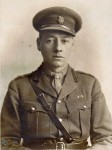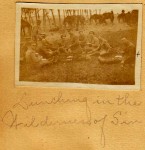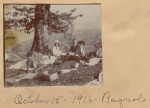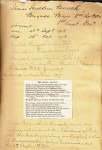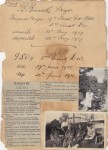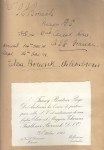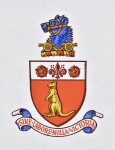BORWICK, Thomas Faulkner
Thomas Faulkner Borwick was the elder brother of Henry Barton Borwick. Both were students studying at Melbourne University and living with their parents, Henry and Hannah Borwick, at 24 Lansdown (sic) St., East Melbourne. Thomas had been educated at Scotch College, East Melbourne and went on to study Mechanical Engineering. He was a member of the Melbourne University Rifles and in his final year when he enlisted on 17/8/1914. He already had a position offered at Vickers Ltd. at Barrow in Furness in Cumberland, England, and had some work experience in Australia. The University awarded him his degree without further examination.
He is described in his enlistment papers as six feet tall, with a fair complexion, brown eyes and dark hair. Following training, he embarked for Egypt on the HMAT Hororata on 19 October 1914. He took part in the landings at Gallipoli on 25 April 1915 as part of the second wave. Ten days later the unit was transferred to Cape Helles. He was wounded on 8 May and was invalided to Malta. He was promoted to Major a week later. He took sick leave in Florence, Italy, returning to Malta before embarking for Egypt on July 26, 1915. He rejoined his unit on 9 August 1915. By February, 1916, he was serving as a Brigade Major in the 2nd Infantry Brigade, but on 29 March 1916 he embarked from Egypt to join the British Expeditionary Force, disembarking in Marseilles.
On 24 July 1916, he was severely wounded at Pozieres when struck by fragments of a high explosive shell. He had multiple wounds, the most severe of which was a perforating wound to the abdominal wall just above the right iliac crest, a lacerated wound on the right arm, a fracture of the 2nd metacarpal bone of the left hand and vitreous opacities of the right eye, with multiple smaller wounds to the arms, face and chest, leaving him unfit for further active service. He was made Brigade Major of the 9th Brigade on 13 November 1916. He was mentioned in General Haig's despatches on 9 April 1917 and was recommended for a Distinguished Service Order on 3 June 1917.
He relinquished his position as Brigade Major on being returned to England, where he was attached on 9 September 1917 as a General Staff Officer to No.2 Group Durrington, then to No 3 Group. In December 1918, he was serving in London with the Demobilisation Section AIF, then in February 1919, he was on duty at the War Records Office in London. He was then sent back to France to the Australian Corps Headquarters and then seconded to the GSO 1 Depot in England. Thomas Borwick ended the war as a Lieutenant Colonel. He was awarded a DSO on June 1917 and was mentioned in dispatches by Sir Douglas Haig. France awarded him the Croix de Guerre. He conintued to play a role in national affairs after the war, as one of the group attending the 1919 Versailles Peace Conference in France with Prime Minister William Morris Hughes.
On discharge, he went to Vickers Ltd in Cumberland, England and in 1918 he married Elsa de Ambrosis, of 59 Via San Domenico, Florence. In 1922-23, a Thomas Faulkner Borwick, BMechEng(Melbourne) is listed as a research student in the Faculty of Engineering in the 1922-23 King's College London Calendar. The list is for the university session October 1921-July 1922. His name does not appear in the listings for sessions 1922-23 or 1920-21. In 1924, he joined the Indian Ordinance Services and was promoted to Director General of Indian Ordinance Factories in 1943. In 1941, he was created a Companion of the Order of the Indian Empire for his military service in Wordl War 11, and in 1946, was knighted. The arms which were granted to him by the College of Arms described his coat of arms as 'Gules a Kangarou sejant Or on a Chef Argent a Florentine Lily between two Rose Gules barbed and seeded proper ', in other words, a red background on which sits a gold kangaroo with, across the top of the shield, a silver band on which sit a Florentine lily in red, with either side of it, two red roses, the roses having no stems and having the centre seeds and small leaves intervening at the outer edge between the petals, represented in their natural colours.' The red background represents the red earth of Australia, with the kangaroo; the Florentine Lily is a symbol of his wife, Elsa, while the two roses represent his children, his son Peter, and daughter, Rosemary.
He died on 12 December 1981 in Surrey, England.
The Argus 26/7/1919 p.13 has the announcement of Thomas Borwick's wedding. He had spent time in Florence on sick leave early in his miltary service.
National Archives
Australian War Memorial
City of Melbourne Rate Books, Gipps Ward, 1905-1910. Ref No. 498 (1906)
Corresondence with Keith Newton

